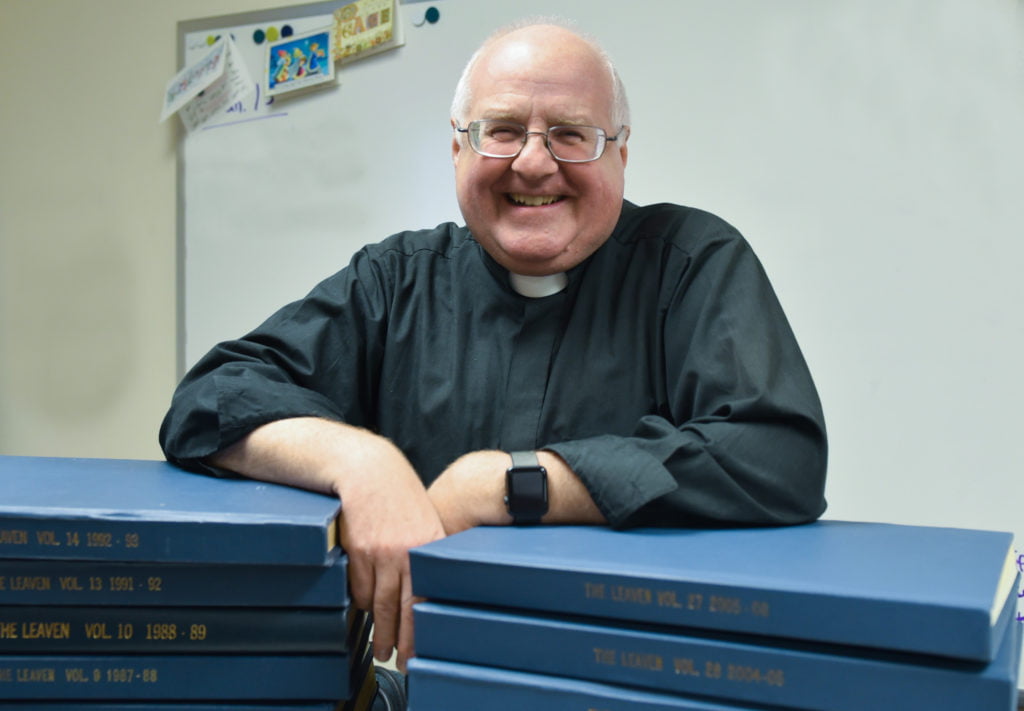
Father Mark Goldasich is the pastor of Sacred Heart parish in Tonganoxie. He has been editor of the Leaven since 1989.
by Father Mark Goldasich
The older I get, the more I wonder: Is everything I learned really just an urban legend?
To be fair, the information about the man in this column would be classified as “mixed” on snopes.com, the website that investigates “urban legends, internet rumors, email forwards and other stories of unknown or questionable origin.” “Mixed” means that there is at least some truth about what most of us learned about this man.
His name is John Chapman, born on Sept. 26, 1774, in Leominster, Massachusetts. He traveled extensively in Pennsylvania, Ohio, Indiana and Illinois, what was then the American frontier. He was a devout missionary of the Church of Swedenborg, also known as The New Church, and never married. Chapman was a vegetarian and a fierce opponent of cruelty to animals and even insects. And he was probably considered a kook, dressed as he was in a coffee sack, sporting a tin pot hat and going barefoot. These biographical notes are reliable.
Things start to get a little dicey when it comes to when he died. Although sources agree that it was in Fort Wayne, Indiana, in 1845, some date his death in the summer of that year, while others believe it was actually on March 11 . . . or March 18.
Oh, by the way, Chapman came to be known as Johnny Appleseed. And it’s when we talk about this frontier folk hero that some “facts” go off the rails. For example, I thought that Johnny Appleseed tossed around those seeds from his bag like a drunken sailor; actually, he planted orchards strategically and for profit. At his death, he owned about 1,200 acres of valuable land.
I also believed that every time I bit into a juicy apple, I had Johnny Appleseed to thank. At least that’s how he was portrayed in the short Disney cartoon about him.
In actuality, Chapman planted “spitters,” or small, tart, inedible apples that were made into hard cider or applejack — in other words, alcohol! Holy cow, Disney conveniently forgot to mention that.
Well, I’m not here to set the record straight on Johnny Appleseed, but rather to use some of his real life as an inspiration for our Lenten journey.
First of all, he was a missionary who taught respect for all of God’s creation. Lent is an ideal time to read — and share — Pope Francis’ encyclical “Laudato Si’, on Care for Our Common Home,” to find inspiration on how to better respect this world and its resources.
Secondly, Chapman was a bit of an eccentric, especially in his attire and philosophy of life. This might be a call not only for us to embrace a simpler lifestyle, but also, in a sense, to be “fools on Christ’s account” (1 Cor 4:10.) Being a person of faith in the world today and advocating for the environment may make us a target of ridicule, but that’s part of the cross that we’re called to bear.
Third, there’s no doubt that Johnny Appleseed changed the apples of America. According to author Michael Pollan, “From Chapman’s vast planting of nameless apple cider seeds came some of the great American cultivars of the 19th century.” Lent is all about transformation, isn’t it? We’re called by prayer, fasting and works of charity to change our own hearts for the better and then to positively influence the world around us.
Perhaps we can do that by planting a spring garden. Although I was not blessed with a green thumb, everyone, I’m sure, can plant a special type of garden based on the following directions:
- Plant three rows of peas: peas of mind; peas of heart; peas of soul.
- Plant four rows of squash: squash gossip; squash indifference; squash grumbling; squash selfishness.
- Plant four rows of lettuce: lettuce be faithful; lettuce be kind; lettuce be patient; lettuce truly love one another.
- Plant three rows of turnips: turnip for meetings; turnip for church services; turnip to help one another.
- Plant three rows of thyme: thyme for yourself; thyme for family; thyme for friends.
Water freely with patience and cultivate with love. (Adapted from an anonymous author)
By cultivating such a garden during these days of Lent, may we become ever more the apple of God’s eye.

